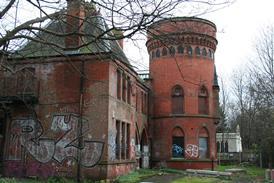Malcolm Reading is still flying the flag for British architecture and architectural competitions, writes Ben Flatman

The world of competitions is a mystery to many. For the young, jobbing architect they can seem like a veil separating them from the inner sanctum of prestige projects and peer approval.
Some see them as rigged, with well-connected judges making sure their starchitect friends come out on top. But for others, architectural competitions represent a genuine opportunity to break through in a crowded field – not a stitch-up, rather a chance for young practices to get that high-profile commission that helps to make their name.
One of the most respected advocates for competitions is Malcolm Reading. He founded his eponymous consultancy in 1996 and he has been working hard ever since to dispel the idea that they are just for the in-crowd.
He believes that competitions have a vital role to play in the architectural ecosystem. And, for decades now, he and his firm have been actively seeking out exciting new practices which he believes have the talent and appetite to succeed.
Lubetkin and building a team
Reading’s education is firmly rooted in architecture, but he has not pursued a conventional career in the built environment. He studied at the University of Bristol school of architecture, which closed in 1984 following government cuts. Right from the beginning he was drawn to architecture because, as he says, it combined his “interest in the built environment and social conditions”.

It was while at Bristol, working in a third-year social design unit, that Reading met Berthold Lubetkin, who was by then living in semi-retirement in the Clifton area of the city. They went on to become good friends, and he describes Lubetkin as an “amazing personality” who had “a very big impact” on his life.
There is clearly an idealism underlying Reading’s work which perhaps reflects the influence of his friend and mentor. “Lubetkin was very politically informed,” says Reading. “He believed architecture could change society for the better. He was ahead of his time.”
Reading developed a particular interest in the collaborative nature of Lubetkin’s practice with Tecton and the way in which it demonstrated that “not everyone had to be the lead architect”. A profound understanding of the importance of building an effective team has gone on to inform much of Reading’s subsequent career.
“There was a real paradox about Lubetkin. What was the alchemy between him and his team of young AA graduates?” ponders Reading.
He also talks about the way in which Lubetkin, although not a particularly talented draughtsman, was able to convey a powerful vision. “His drawing was very poor but his writing amazing. He was such a great communicator,” says Reading. The importance of writing and narrative in conveying ideas around design and architecture was to have a lasting impact.
British soft-power and the importance of heritage
After working briefly as a freelance writer and as an architect, Reading went on work as director of architecture and design at the British Council, a job that he describes as giving him a “calling card for partnerships and collaboration”. It was at the British Council that he first found himself “selecting architects both internationally and from the UK” to work on new outposts of British soft-power.
With its remit as Britain’s cultural relations organisation, the British Council role required him to “showcase the UK”. It is a theme that continues to run through his work today, with Malcolm Reading Consultants (MRC) often advocating for British architects outside the UK. This exposure to working internationally and engaging with diverse stakeholders is something that he has built on in his later career.
At the British Council he says it was “important to show the ethos of collaborative design with local architects”. This often manifested itself through the appointment of UK practices to undertake the concept design work, with local practices overseeing implementation on the ground.
This idea of matching UK designers with local partners carries through to the collaborative approach that he encourages in his consultancy today.
As part of the British Council job, Reading was tasked with helping to open new cultural centres in eastern Europe. “When I joined, it was the time the Berlin wall came down,” he says. He became a regular visitor to the former Eastern bloc, scouting out locations and in the process becoming what he describes as “a peripatetic commissioner of architecture”.
Heritage also became a key plank of Reading’s career. While at the British Council he was often looking at repurposing older buildings, particularly in eastern Europe. “The British Council gave me a real taste for heritage,” says Reading, who was recently a board member for English Heritage and Edinburgh World Heritage, and is a member of the Sovereign Grant Audit Committee.
This experience continues to inform MRC’s approach today, and means that they are often appointed for projects with a historical significance. “We’re very respectful of place,” he says of his work today.
Filling a niche as expert client adviser
After six years, and with a young family, Reading found the amount of travel required with the British Council was increasingly “too much” and, by the mid-1990s, made the decision to leave. The experience had given him a unique insight into how clients work with architects, and how to successfully assemble project teams in complex environments. The seeds had been sown for MRC, but the full breadth of services would develop gradually over time.
One of Reading’s lightbulb moments came when he realised that “lots of institutional clients commission once in their careers but never again”. He saw that clients were gaining knowledge through implementing buildings, but that they rarely carried that over into another building.
He came to see that around the world clients were working in isolation on separate procurement processes, drawing up unique project briefs, but this knowledge was often being lost and having to be re-learnt every time a building was procured. He perceived a need for an expert adviser role to guide clients through the process of commissioning a building.
Initially, the consultancy worked mainly on helping clients to write briefs for building projects. “We began with project briefs” he says, “and morphed into competitions.”
The expansion was a natural step for the consultancy that reflected a growing desire to provide an end-to-end client service that covered project inception and project management through to completion. Reading describes his firm now as a “a bridge between architects and clients”.

The senior team at MRC are mainly architects, but there is a strong emphasis on writing and the ability to tell a story. Reading attributes much of this to his wife, Catherine Reading, who is creative director and has a background as a writer and poet.
“Catherine realised that no one was systematically pulling together a clear narrative,” he says. Each brief is now conceived in narrative terms, with the MRC team seeking to help clients articulate a more profound vision that goes beyond square footage and function.
Using competitions to break down barriers
Reading sees his role today as challenging restrictive procurement processes, driving up design standards and helping open up opportunities to younger firms. He realised early on that “procurement processes were stacked against emerging (often younger) practices”.
He believes that conventional institutional procurement routes have stifled creativity and cut off access to younger practices that cannot meet what are often stringent criteria for getting onto shortlists. He wants to take commissioning buildings “out of the procurement approach, to make it something quite magical”.
He talks enthusiastically about the way in which the competition process has helped young practices grow. “Competitions can inspire people,” he says.

Talking about Feilden Fowles’s successful competition entry for Homerton College in Cambridge, he says: “When we put them on the shortlist, they were on the cusp. I feel that we were an important part of their evolution.”
He also highlights the valuable exposure that competitions can bring. “They are great publicity and attract attention from outside the industry.”
MRC’s biggest open competition was for the Helsinki Guggenheim, which attracted 1,715 entries.
>> Also read: More than 1,700 enter Helsinki Guggenheim competition
“Although the political climate in Finland meant the project wasn’t realised, the competition stimulated a global debate around museum design,” he says. “We read a lot of architects’ backstories, and the Guggenheim often pops up as a point of reference.”
Today, MRC has a network of 8,000 firms all over the world that it keeps in mind for competitions. A variety of approaches is taken, with some competitions being invite-only and others entirely open. Reading seeks to ensure that procurement rules are kept to a minimum.
“Procurement rules act against younger practices,” he says. “We spend a lot of time trying to avoid unnecessary bureaucracy.”
One example is where there is a PI requirement. MRC encourages clients to stipulate that firms only need acquire this once they have won the competition; and to allow more creativity in interpreting what is relevant experience.

He points to the Homerton College competition as an example, where the first stage was open to anyone declaring an interest, with no procurement rule requirements. Another case was the British Antarctic Survey competition.
Reading says that had the client required previous experience, then only US firms would have had the necessary body of work. Again, MRC advocated flexibility and Hugh Broughton Architects was able to come through and win.
Going global and supporting diversity
The move into competitions also led to more work outside the UK. “What’s been really nice is that almost immediately we became 80% international,” Reading says, before noting that “overseas clients are very interested in British design”.
Although his British Council days are far behind him, he remains a strong advocate for UK industry. “One of the big exports for the UK is design,” he says.
“What we’ve seen is that talent and creativity is a real calling card across the world. Clients are very responsive to UK design and usually barriers to working outside the UK are very low.”
Many clients want to have invited competition, when rules allow. These often start with a pool of 30 to 40 firms and then MRC works with the client to come up with a shortlist.
Rather than relying on the existing network or familiar names, MRC will often go out and actively seek firms that it thinks are appropriate.
“We follow people as they leave firms and start up on their own,” Reading says. He describes his own team as enjoying the process of finding new talent and bringing it to the attention of clients.
“Clients like to see diverse lists. Usually we have some international firms plus younger firms.”
And he sees an increasing move towards clients looking for partnerships between established larger practices and rising stars. He points to Asif Khan’s collaboration with Stanton Williams on the new Museum of London as a prime example.
>> Also read: Shortlisted teams unveil Museum of London designs
Defending the role of competitions, Reading says: “Competitions represent a tiny percentage of how buildings are procured. Most are procured through frameworks, with lowest fees and repeat work a crucial factor.”
He sees MRC’s role as facilitating ways for architects and clients to come together and says he has “worked hard on lots of recent competitions to match young up-and-coming architects with more established names”.
MRC works hard to try and ensure that practices get compensated for any work that they do, especially if they are invited to the shortlisted intensive design stage of a competition, where practices undertake six to eight weeks of work, usually in close consultation with MRC and the client.
Reading advises those considering entering competitions to think carefully how much resource and effort they require. He highlights the benefits as being good PR and the opportunity to get your work published, even if you are just on the shortlist.
“Often clients notice a second-placed entry on a competition,” he says. “Competitions help practices to hone in on the clients they want to attract.”
So what does it take to win a competition? “It’s such a test of your maturity as a firm” Reading says. “I think competitions are the moment at which architects cross a threshold.”
He points to Heatherwick’s successful win of the UK pavilion at the Shanghai World Expo. “It’s not just business. You have to have a hunger in the office.”
Key components for a well-run competition
The client
Most architects would agree that a good client lies at the heart of most good projects. “You need a client who is open to ideas”, says Reading, who often encourages clients to enter into a dialogue with prospective architects, both to explore the project’s potential and ensure that both parties are a good fit.
MRC vets clients carefully to make sure that they are “committed to a real project” and not just looking for publicity. This usually includes a requirement that entrants will be paid to enter the competition, especially for the very time-consuming later stages.
The architects
“They have to have a creative curiosity,” says Reading of prospective competition entrants, “and an interest in being able to show their work against their peers.
“Not every architect is the right architect to enter competitions,” he says. “They have to see it as a part of a business strategy – getting noticed.”
The process
“You need an impeccable, independent and transparent process. We aim to be scrupulous, fair and independent. We publish reports after each competition and insist clients settle obligations.”
Most competition design stages run over a six to eight-week period. “It’s a great way to test your A team,” says Reading.
Those entering competitions need to be good at collaboration, he adds. Most of MRC’s competitions are entered as teams, with an architectural practice in the lead, but a team of engineers and associated consultants already identified.
“We want a creative collaboration throughout.”
Postscript
For those interested in getting on MRC’s radar, the consultancy runs a surgery every Friday, and they usually see two or three firms a week. Here Malcolm Reading offers advice on what steps to take if you are interested in a relationship with MRC.
1. “Firstly, reach out to us.” The team can be contacted at hello@malcolmreading.com and you can join the mailing list here.
2. “Don’t show us everything. Think about what the size of project you want to work on and be selective. Think of it in terms of appealing to a client.”
3. “Be strategic but also patient. It takes time to build momentum and get your pitch right. Each competition helps you refine your thinking.”
















No comments yet